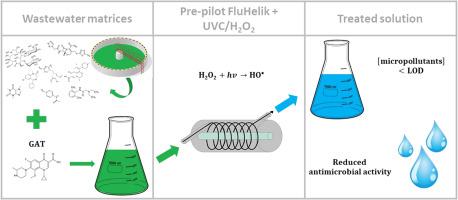Journal of Environmental Chemical Engineering ( IF 7.4 ) Pub Date : 2021-01-10 , DOI: 10.1016/j.jece.2021.105060 Jonathan C. Espíndola , Marlon Caianelo , Nazareno Scaccia , Caio Rodrigues-Silva , José R. Guimarães , Vítor J.P. Vilar

|
The main goal of this study is to evaluate the feasibility of the innovative FluHelik photoreactor for the removal of antimicrobial drugs at residual concentrations using a photochemical UVC/H2O2 process. Experiment studies were performed using either pure water (PW) or secondary effluent from municipal wastewater treatment plant (EW) fortified with gatifloxacin (GAT) (100 µg L−1) as a model antimicrobial contaminant. Initially, the efficiency of the UVC/H2O2 process towards GAT removal as a function of UVC lamp power (4–11 W), H2O2 dose (25–200 mg L−1), flow rate (20–180 L h−1), flow mode (single vs multiple pass) and matrix (PW or EW) was assessed. Afterwards, the system efficiency was evaluated according to engineering features such as association of reactors in series and scale-up design. The performance of the FluHelik reactor was quantitatively measured through the use of a figure-of-merit, photochemical space-time yield (PSTY), that encompasses the three main contributing factors in UVC/H2O2 systems (i.e. throughput, energy efficiency and photochemical oxidation). In this context, FluHelik scale-up to pre-pilot scale proved to be feasible as similar PSTY values were obtained at both scales for assays performed with EW. In addition, the pre-pilot scale system was able to degrade all pharmaceutical compounds originally detectable in the EW matrix, reducing their concentrations to values below limit of detection. Finally, in order to test whether the treated solution might develop antibiotic resistance when in the environment, antimicrobial activity assays using bacterial cultures of Bacillus subtilis and Escherichia coli were investigated. The antimicrobial activity in the solutions dropped as the reaction time increased.
中文翻译:

使用FluHelik反应器从市政废水中去除痕量有机污染物:从实验室规模到试点规模
这项研究的主要目的是评估创新的FluHelik光反应器使用光化学UVC / H 2 O 2工艺去除残留浓度的抗菌药物的可行性。使用纯水(PW)或市政污水处理厂(EW)的二次污水进行了实验研究,污水中加有加替沙星(GAT)(100 µg L -1)作为模型抗菌污染物。最初,UVC / H 2 O 2去除GAT的效率取决于UVC灯功率(4-11 W),H 2 O 2剂量(25-200 mg L -1),流速(20- 180升h -1),流动模式(单次通过与多次通过)和矩阵(PW或EW)进行了评估。之后,根据工程特性(例如串联的反应堆和按比例放大的设计)评估系统效率。FluHelik反应器的性能通过使用品质因数光化学时空产率(PSTY)进行定量测量,其中包括UVC / H 2 O 2的三个主要影响因素系统(即吞吐量,能效和光化学氧化)。在这种情况下,将FluHelik放大到试点规模被证明是可行的,因为在两种比例下都获得了类似的PSTY值,用于用EW进行的测定。此外,试点前规模的系统能够降解最初在EW基质中可检测到的所有药物化合物,从而将其浓度降低至低于检测极限的值。最后,为了测试处理后的溶液在环境中是否会产生抗生素抗性,研究了使用枯草芽孢杆菌和大肠杆菌进行细菌培养的抗菌活性测定方法。随着反应时间的增加,溶液中的抗菌活性下降。











































 京公网安备 11010802027423号
京公网安备 11010802027423号